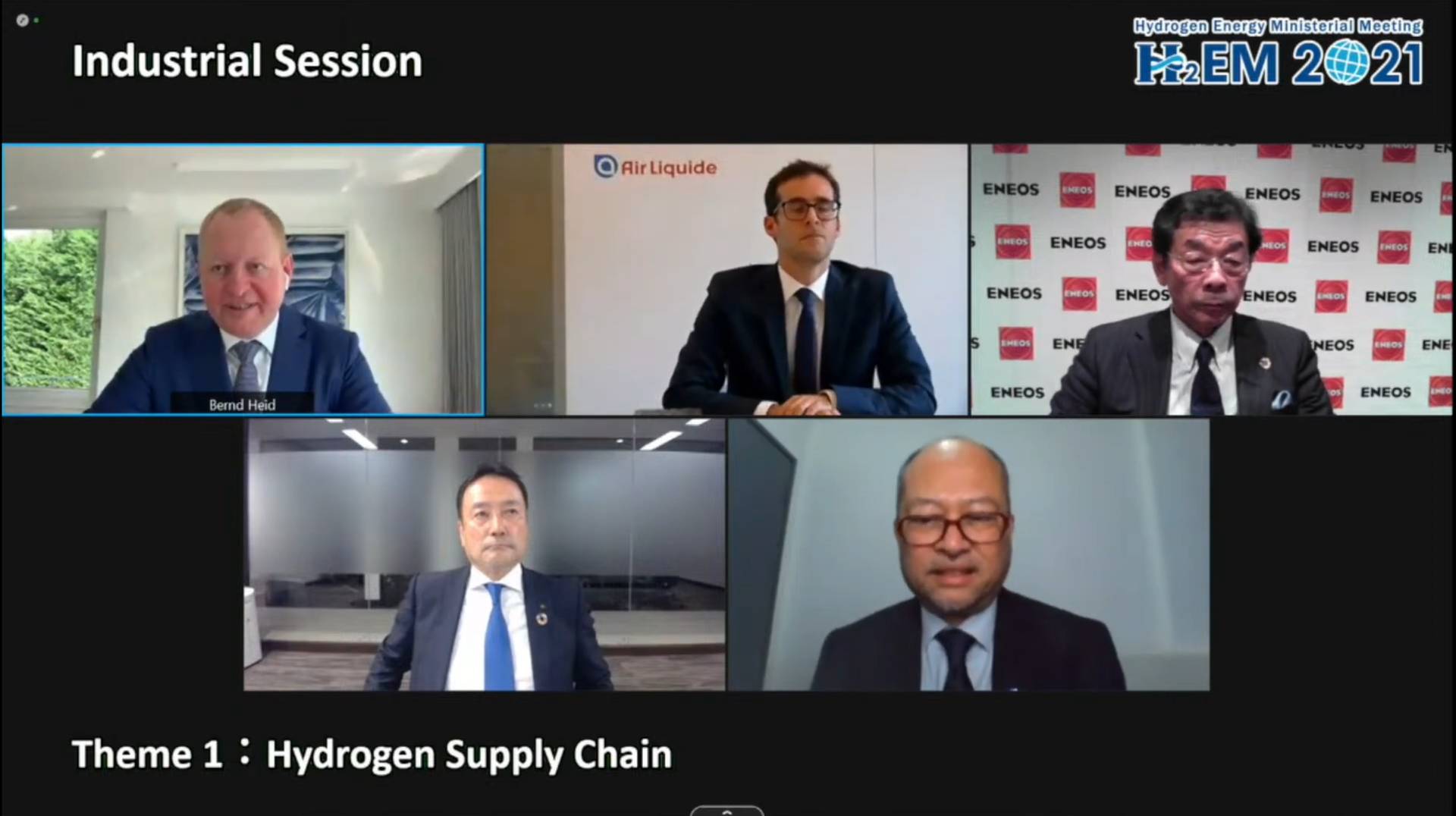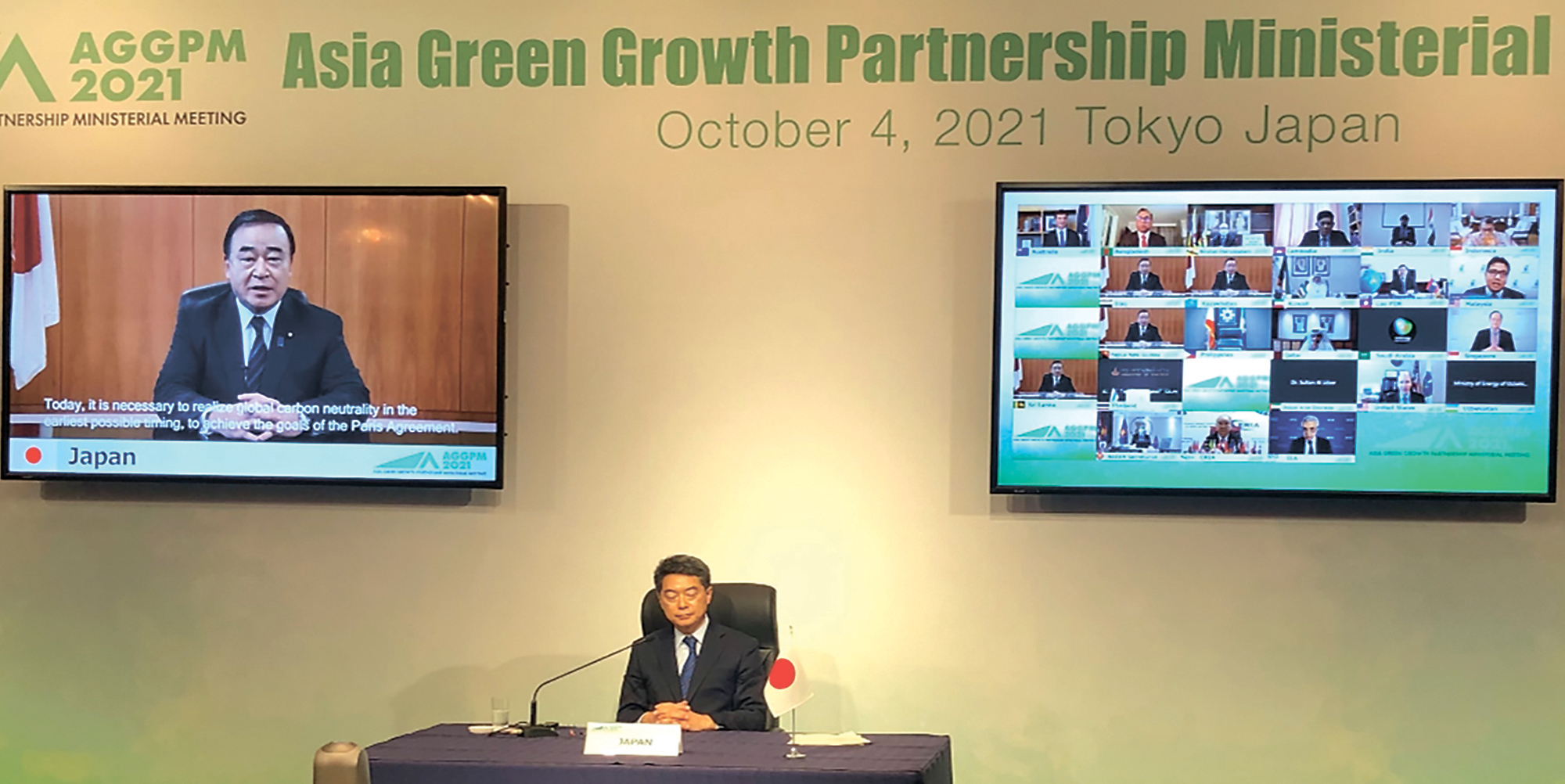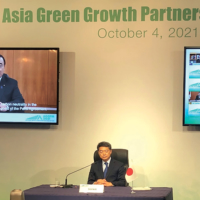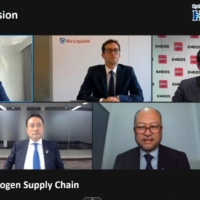Japan is heading toward its goal of achieving net-zero emissions by 2050. But it is also determined to work toward another target — to help other countries, especially those in Asia, create a carbon neutral society.
Many developed countries submitted bold action plans for curbing greenhouse gas emissions to the United Nations ahead of this month’s COP26 climate summit in Glasgow, but what seems to be essential is to also bring emerging economies onboard.
Part of Japan’s effort to do this was a series of international conferences collectively called “Tokyo Beyond Zero Week 2021,” held by the government between Oct. 4 and 8.
About 17,000 people attended TBZW 2021, where people from both the public and private sectors discussed various issues surrounding energy and the environment to achieve carbon neutrality and shared knowledge toward that goal.
“Today, it is necessary to realize global carbon neutrality in the earliest possible timing, to achieve the goals of the Paris Agreement. Asia is no exception to this. Japan will actively contribute to achieve green growth in Asia and to accelerate its energy transitions,” former Minister of Economy, Trade and Industry Hiroshi Kajiyama said in a video message at one of the conferences, the first Asia Green Growth Partnership Ministerial Meeting (AGGPM), on Oct. 4.
The seven other conferences held as part of TBZW 2021 were the third International Conference on Carbon Recycling, the fourth Hydrogen Energy Ministerial Meeting, the 10th LNG Producer-Consumer Conference, the third Task Force on Climate-related Financial Disclosures (TCFD) Summit, the first International Conference on Fuel Ammonia, the eighth Innovation for Cool Earth Forum (ICEF) and the third Research and Development 20 for Clean Energy Technologies (RD20).
The need for action toward net-zero is an especially urgent task in Asia. According to the International Energy Agency, overall energy demand in Southeast Asia is expected to grow by 60% compared to 2018 levels by 2040, and fossil fuels would still represent some 80% of the total energy demand in 2040.
In addition, overall demand for electricity in the region is projected to double in the next 20 years, with fossil fuels accounting for around 70% of all power generated in 2040.
Given such projections, Japan proposed a comprehensive package of measures called the Asia Energy Transition Initiative (AETI) to support transitions in the Association of Southeast Asian Nations, at the Special Meeting of ASEAN Ministers on Energy and Japan’s economy, trade and industry minister in June.
In addition to pledging $10 billion of financing support for renewable energy, energy efficiency, liquefied natural gas (LNG), CCUS (carbon dioxide capture, utilization and storage) and other projects in Asia, Japan has asked those countries to formulate energy transition road maps toward implementing carbon neutrality. It will also promote an Asian version of energy transition finance and support development and deployment of the necessary technologies through the creation and utilization of a ¥2 trillion fund.
Japan has also announced that it will help in the areas of human resource development and knowledge-sharing on decarbonization technologies under AETI.
“It’s not that we are pressuring these nations to achieve net-zero by a certain year. Instead, we asked them to come up with their own target year to go carbon neutral and help them draw realistic road maps toward that goal,” said Takeshi Soda, director for international affairs at METI’s Agency for Natural Resources and Energy. “And we will finance projects and deployment of technology under the road maps.”
At the AGGPM, ministers as well as delegates from 22 countries and international organizations welcomed Japan’s initiatives during the conference.
They acknowledged the need for all countries to make efforts and contributions to achieve global carbon neutrality at the earliest possible time.
Behind this sense of urgency in emerging economies is the common dilemma of fossil fuel divestment, in which investors increasingly withdraw from companies involved in extracting fossil fuels in a political attempt to slow climate change.
“If this divestment campaign continues, they can no longer expect financial assistance from international investors for their energy infrastructure, which is still necessary for their economic growth,” Soda said.
The Chair’s Summary also noted that “it is essential to establish a framework that financially supports technologies and projects contributing to energy transitions, and to explore the concept of ‘Asia Transition Finance’ by the ‘Asia Transition Finance Study Group’ led by private financial institutions.”
With the cooperation of the Economic Research Institute for ASEAN and East Asia (ERIA), Japan has already started working with some ASEAN countries to help them come up with their own road maps.
Based on present and projected data, including energy mix, industry structure, renewable energy prices and power demand and supply, ERIA will come up with the best model for each country, showing how and when to adopt certain renewable energies, and propose the cheapest ways to achieve carbon neutrality.
Fatih Birol, executive director of the International Energy Agency, said in his opening remarks at the AGGPM that “there is no one-size-fits-all” for clean energy transitions and the pathway will be shaped by each country’s circumstances and capabilities.
He also emphasized that three technologies — CCUS, low-carbon fuels (such as hydrogen and ammonia) and LNG — would play an important role in the energy transitions.
At the fourth Hydrogen Energy Ministerial Meeting, delegates from 29 countries, regions, international organizations and industry associations, as well as private corporate representatives, shared information on the latest hydrogen-related technologies, hydrogen supply chains and policy direction.

At the conference, the IEA announced that it had compiled Global Hydrogen Review 2021 to provide policymakers with advice and information on the latest global trends.
Many countries have already set hydrogen strategies because they realize that it will be extremely difficult to achieve net-zero without utilizing hydrogen technology. However, many challenges remain.
For example, Megan Woods, New Zealand’s minister of energy and resources, said that for the hydrogen market to scale up, the cost of green hydrogen production must decline. For delivery, standards must also be established to enable safe and low-cost transportation, she said.
In the private sessions, participants shared information about companies’ initiatives in building hydrogen supply chains, examples of communities introducing hydrogen use and various challenges to achieve further market development.
As the role of sustainable finance increases, participants of the third Task Force on Climate-related Financial Disclosures (TCFD) Summit exchanged opinions to develop more effective climate-related corporate disclosures based on TCFD recommendations.
TCFD was established in 2015 to develop consistent climate-related financial risk disclosures for use by companies, banks and investors in providing information to stakeholders. Its recommendations are designed to help public companies and other organizations disclose climate-related risks and opportunities.
Since the last TCFD Summit in October 2020, more than 1,000 organizations became TCFD supporters, bringing the total to 2,529 worldwide as of Sept. 30.
At this year’s summit, participants agreed that the role of asset owners is significant, and it is important to obtain commitments for carbon neutrality from investors through engagement rather than divestment.
Many also expressed the importance of corporate strategy on transition, which is expected to be disclosed in the TCFD framework as suggested in the newly amended TCFD guidance.
The energy agency’s Soda said that all the topics discussed during TBZW 2021, such as hydrogen, ammonia, LNG, research and development and TCFD, are integral elements in achieving carbon neutrality.
“The TBZW conferences were highly significant because the series of the conferences can contribute to promote the discussion and cooperation among many countries, including developing nations, toward achieving carbon neutrality at the earliest possible time,” Soda said. “And when working toward that goal, they will try to keep the balance of three E’s (energy security, environment and economic growth), which has been emphasized by the Japanese government.”
As Japan is helping some countries with their road maps, Soda added that the next challenge after the conferences will be to actually secure the funding for projects included in the road maps.
“We hope to become a driving engine to lead Asia toward net-zero emissions. To do that, we must create a successful model for other countries to follow.”
This page is sponsored by the government of Japan.






